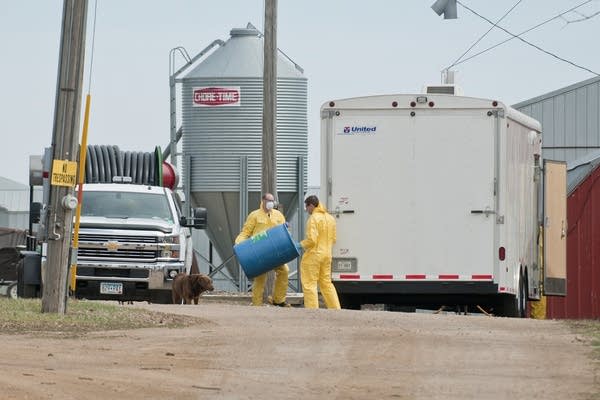In fight against avian flu, state looks for diseased birds

Go Deeper.
Create an account or log in to save stories.
Like this?
Thanks for liking this story! We have added it to a list of your favorite stories.
As a deadly outbreak of avian influenza continues to spread in Minnesota, the state Department of Natural Resources is trying to locate disease-carrying birds.
In Minnesota more than 300,000 turkeys have died from the disease or been killed to prevent the virus from spreading.
In their search, investigators are particularly interested in dead birds of certain species, including hawks and eagles, said Michelle Carstensen, a wildlife health program supervisor for the DNR.
"We've increased vigilance statewide, within our agency, for any reports of dead raptors or wild turkeys which could be indicators of virus in the environment," Carstensen said.
Turn Up Your Support
MPR News helps you turn down the noise and build shared understanding. Turn up your support for this public resource and keep trusted journalism accessible to all.
For the state's more than $800 million turkey industry, the disease is a big economic worry. The virus can kill thousands of turkeys in a few days, leaving a farmer with a devastating financial loss, said Steve Olson, executive director of the Minnesota Turkey Growers Association.
"If the virus comes into their flock and it wipes out their flock, they're not getting paid for that," Olson said. "They're not getting any kind of reimbursement. There's no way to insure for that. So they take the full brunt of that."
Those concerns were heightened when state officials announced that seven turkey flocks have been infected, including additional two announced Monday.
Most of the infected flocks are in the adjacent counties of Stearns, Kandiyohi and Pope in central Minnesota.

"National veterinary services laboratory confirmed two more affected farms in Minnesota," state veterinarian Bill Hartmann said during a conference call Monday. "One in Stearns County, and that farm has approximately 76,000 turkeys on it. And one in Kandiyohi County which has about 26,000 turkeys in it."
Typically the infection of domestic turkeys traces back to wild ducks and geese or other waterfowl, which can carry the virus without getting sick, Hartmann said. Investigators believe they carried the virus into the state.
Generally waterfowl spread the virus through their fecal material. They may deposit the bug directly onto a farm site, or it may be tracked onto a farm by truck tires, human feet or other methods. But workers on turkey farms typically don protective boots before they enter a barn.
If that step is effective, Hartmann said, it's still a mystery exactly how the virus is moving from outside the barn to the inside where the turkeys live.
"We don't know the exact mechanism," he said.
Besides researching that question, investigators also are testing more wild waterfowl near the affected turkey operations, to see if they can locate disease-carrying birds. They think there may be a viral hotspot near the infected farms.
The government does reimburse farmers for apparently healthy birds that are killed to prevent the disease from spreading.
Still, farmers face another economic hit. More than three dozen countries have banned turkey products from Minnesota and other states with outbreaks. Olson said Mexico has been helpful, with only a partial ban in place. He said Mexico is still buying turkey meat that will be processed south of the border into turkey ham or some other product.
Olson said he won't be surprised if a few more turkey operations are hit with avian influenza, largely because so many waterfowl potentially carrying the disease are now migrating through the state. But the virus is not nearly so virulent in summertime warmth, said Olson, who hopes the end of the current outbreak is in sight.
"Normally after mid-May, end of May, then we typically, historically have not seen influenza viruses around," he said.
But that's still a month or more away, and the virus is still active.



